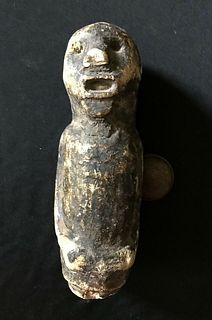Tall 6th C. Filipino Limestone Burial Urn Figural Lid
Lot 68a
About Seller
Artemis Gallery
686 S Taylor Ave, Ste 106
Louisville, CO 80027
United States
Selling antiquities, ancient and ethnographic art online since 1993, Artemis Gallery specializes in Classical Antiquities (Egyptian, Greek, Roman, Near Eastern), Asian, Pre-Columbian, African / Tribal / Oceanographic art. Our extensive inventory includes pottery, stone, metal, wood, glass and textil...Read more
Categories
Estimate:
$5,500 - $8,500
Absentee vs Live bid
Two ways to bid:
- Leave a max absentee bid and the platform will bid on your behalf up to your maximum bid during the live auction.
- Bid live during the auction and your bids will be submitted real-time to the auctioneer.
Bid Increments
| Price | Bid Increment |
|---|---|
| $0 | $25 |
| $300 | $50 |
| $1,000 | $100 |
| $2,000 | $250 |
| $5,000 | $500 |
| $10,000 | $1,000 |
| $20,000 | $2,500 |
| $50,000 | $5,000 |
| $100,000 | $10,000 |
| $200,000 | $20,000 |
About Auction
By Artemis Gallery
Jun 27, 2024
Set Reminder
2024-06-27 11:00:00
2024-06-27 11:00:00
America/New_York
Bidsquare
Bidsquare : Connoisseur's Delight Fine Art & Antiquities
https://www.bidsquare.com/auctions/artemis-gallery/connoisseurs-delight-fine-art-antiquities-16181
Classical antiquities, ancient and ethnographic art from cultures encompassing the globe. Artemis Gallery info@artemisgallery.com
Classical antiquities, ancient and ethnographic art from cultures encompassing the globe. Artemis Gallery info@artemisgallery.com
- Lot Description
**This item is heavy/oversized and will require 3rd party shipping. Please inquire about shipping cost prior to bidding.**
Southeast Asia, Philippines, Mindanao, Lumad culture, ca. 500 to 900 CE. A large limestone burial urn with a lid, carved into the form of an anthropomorphic being. The elongated body tapers to a flattened base, the sides are fluted, and the interior is hollowed out, the thick rim supporting the slightly domed lid. The figure is depicted from the waist up with breasts, and hands resting on the rim as if it forms a skirt, and a face with a gaping mouth, and an elaborate coiled headdress or hair knot. The figural lid indicates the deceased's gender and their social class - elite members of society had anthropomorphic lids and the hairstyle is also likely an indicator of social class. Although large and heavy, this is much too small for an intact body any larger than an infant. This vessel was used in secondary burial practices, bones were placed inside after decomposition. It was common to reinter the skeletal remains of the deceased in smaller vessels after their initial burial. Size w/ lid: 9" W x 37.5" H (22.9 cm x 95.2 cm)
The verso of the lid has the National Museum of the Philippines label on it, indicating this was registered and/or sold by the museum - a common practice in the 20th century for overstocked artifacts.
Provenance: private Hawaii, USA collection, acquired from Material Culture; private Florida, USA estate collection acquired from J.D. Antiques, Jaime Delgado, Manilla, 2003.
All items legal to buy/sell under U.S. Statute covering cultural patrimony Code 2600, CHAPTER 14, and are guaranteed to be as described or your money back.
A Certificate of Authenticity will accompany all winning bids.
We ship worldwide and handle all shipping in-house for your convenience.
#185192Old National Museum of the Philippines label on the verso of lid, and old collector's inventory number as well. Chips and losses to the figure, but overall excellent preservation. Gouges and losses to rock layers on the body of the vessel and rim. No repairs or restoration. The limestone has leaves a chalky white residue when handled.Condition
- Shipping Info
-
All shipping is handled in-house for your convenience. Your invoice from Artemis Gallery will include shipping calculation instructions. If in doubt, please inquire BEFORE bidding for estimated shipping costs for individual items.
-
- Buyer's Premium



 EUR
EUR CAD
CAD AUD
AUD GBP
GBP MXN
MXN HKD
HKD CNY
CNY MYR
MYR SEK
SEK SGD
SGD CHF
CHF THB
THB













